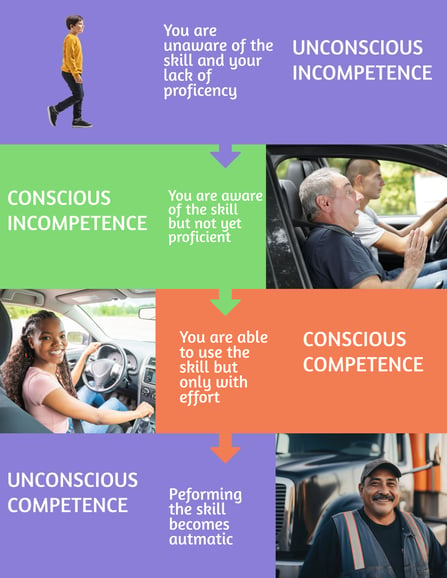In today's rapidly evolving workplace, organizations face the ongoing challenge of ensuring their employees have the necessary skills and knowledge to thrive. Training programs are pivotal in addressing this need, but their effectiveness often hinges on how well they are integrated into employees' day-to-day activities. One model that has proven particularly effective in this regard is the Conscious Competence Model. In this blog, we'll explore the effectiveness of this model for embedding and sustaining training programs within organizations.
Understanding the Conscious Competence Model:
The Conscious Competence Model, also known as the Four Stages of Learning, was developed by psychologist Noel Burch in the 1970s. It describes the process of acquiring new skills or knowledge and progressing through four distinct stages:

- Unconscious Incompetence: At this stage, individuals lack awareness of their incompetence in a particular skill or knowledge area. They may not realize that they need training or development in this area.
- Conscious Incompetence: In this stage, individuals become aware of their deficiencies and recognize the need for training or skill development. They actively seek out learning opportunities to improve their performance.
- Conscious Competence: As individuals receive training and practice the new skill or knowledge, they begin to demonstrate competence, which requires conscious effort and concentration. They must actively apply what they have learned to perform effectively.
- Unconscious Competence: In the final stage, competence becomes second nature to individuals. They can perform the skill or task effortlessly and automatically, without conscious thought or effort.
Embedding Training Programs using the Conscious Competence Model:
The Conscious Competence Model provides a structured framework for embedding training programs within organizations effectively:
- Awareness: The first step is to raise awareness among employees about the importance of continuous learning and development. By highlighting the benefits of acquiring new skills or knowledge, organizations can help employees recognize areas where they may be lacking and encourage them to seek out training opportunities.
- Skill Development: Once employees acknowledge their areas of incompetence, organizations can provide targeted training programs to help them develop the necessary skills. These programs should address specific learning objectives and provide hands-on practice and feedback to promote skill acquisition.
- Application and Practice: As employees progress through the training program, they move into the conscious competence stage, where they can apply their newly acquired skills in real-world scenarios. Organizations should encourage employees to practice what they have learned and provide opportunities for reinforcement and refinement.
- Integration into Workflow: To sustain the impact of training programs over time, organizations must integrate newly acquired skills into employees' day-to-day activities. This may involve providing ongoing support and resources, creating peer learning and collaboration opportunities, and aligning training objectives with organizational goals and priorities.
Sustaining Training Programs using the Conscious Competence Model:
The Conscious Competence Model also offers insights into sustaining training programs beyond the initial implementation phase:
- Continuous Reinforcement: Even after employees achieve unconscious competence, ongoing reinforcement is essential to maintain and enhance their skills. Organizations can leverage strategies such as refresher courses, coaching, and performance feedback to reinforce learning and encourage continuous improvement.
- Cultivating a Learning Culture: Organizations must foster a culture that values and prioritizes learning and development at all levels. Organizations can create an environment where learning becomes ingrained in the organizational DNA by promoting a growth mindset and encouraging knowledge-sharing and collaboration.
- Monitoring and Evaluation: Regular monitoring and evaluation are critical for assessing training programs' effectiveness and identifying improvement areas. Organizations should collect participant feedback, measure performance metrics, and adjust training initiatives as needed to ensure they remain relevant and impactful.
Conclusion:
The Conscious Competence Model provides a powerful framework for embedding and sustaining organizational training programs. By guiding employees through the stages of learning and providing support at each step of the process, organizations can effectively equip their workforce with the skills and knowledge needed to succeed in today's dynamic business environment. By embracing the principles of the Conscious Competence Model, organizations can create a culture of continuous learning and development that drives individual and organizational success.
Talent Optimizers design Team Development Programs that support the Conscious Competence Model. It all starts with a Talent Optimization Health Check, which allows us to determine focus areas and vital benchmark data to track ROI. To get started, click the link below.
.png)

.png)
.png)
.png)